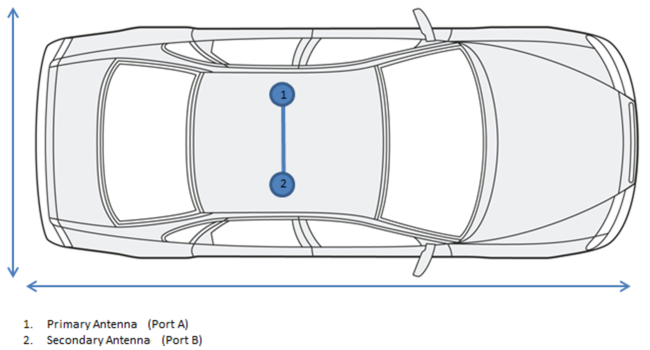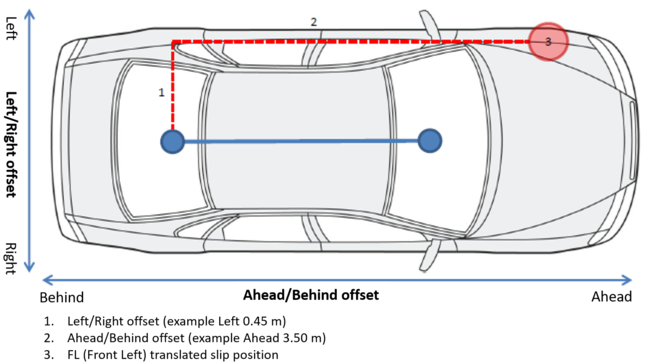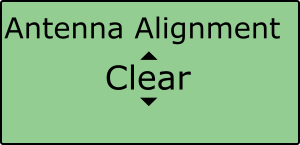Dual Antenna VBOX Speed Sensors
The Dual Antenna VBOX Speed Sensor (VBSS100SL) is a high-accuracy, 100 Hz, GPS/GLONASS system. It combines high-level accuracy and test repeatability with the ability to measure slip and pitch/roll angles at 100 Hz.
The VBSS100SL package includes VBOX Manager, which enables the user to set up the dual antenna separation, change the dynamic modes and level and align the antennas.
You can use the Dual Antenna BOX Speed Sensor straight from the box. It will output digital and analogue signals according to the default settings. You can change these settings in the VBOX Setup Software. Learn how to do this here.
Mounting
The Dual Antenna VBOX Speed Sensor should be securely mounted inside the vehicle, level with the ground. There are holes in the ground plate that can be used to fasten the Speed Sensor to a suitable location in the vehicle. Make sure that the surface with the LEDs and pin information is up.
 |
Antenna Placement
Even though installing and using the Dual Antenna VBOX Speed Sensor is intended to be fast and simple, you must pay careful attention to the placement of the antennas.
Antenna A is the primary antenna, on which all calculations are based. You should place the primary antenna relative to where you wish to take your measurements. For example, if you wish to make measurements from the centre of the vehicle, you achieve this by placing the primary antenna at the centre of the vehicle or translating the position using the slip angle translation function in VBOX Manager.
The measured distance between the antennas should be the straight-line distance between the antennas regardless of the mounting angle. It is not the 2D distance between the antennas as viewed from above.
Use the supplied tape measure to ensure accurate antenna separation.
Important: It is essential that the separation between Antenna A and Antenna B is exactly the same as the separation value set for the Speed Sensor via the VBOX Manager or the VBOX Setup Software. If the distance is incorrect, your data may be inaccurate or not captured at all.
Satellite Elevation Mask (Dual Antenna units only)
You can use this feature to improve GPS signal quality when nearby obstacles like trees and building are reflecting or temporarily obscuring the signal from satellites at low elevation. Raising the mask will cause the GPS engine to ignore satellites below the mask angle. You must use it carefully, though, as it also reduces the total number of received satellites.
You can change the elevation mask angle under the GPS tab in the VBOX Setup Software or by using a VBOX Manager.
.png?revision=1)
Setup
Racelogic developed the VBOX Manager to control the operating functions of a Dual Antenna VBOX Speed Sensor. This section describes how to set up your vehicle with two antennas.

Menu
In the 'Dual Antenna' menu, select 'Dual Antenna Mode', scroll to 'Enable' and confirm. Now you should be able to see the full Dual Antenna system menu.
 |
 |
 |
 |
Antenna Separation
The most important factor for dual-antenna testing is the correct configuration of the separation distance between the two antenna centre points. This allows the Speed Sensor to acquire and maintain the dual-antenna lock. You need to measure the physical separation distance between the two antennas, as accurately as possible, and enter it into the Separation option in the Dual Antenna menu.
To provide a consistent reference, you should align the two antennas with the gold antenna connectors pointing in the same direction. This allows the system to perform a physical reference measurement, connector to connector.
Where possible, you should place the antennas on a level plane. The measured distance between the antennas should be the 2D distance between the antennas as viewed from above. It is not the straight-line distance between the antennas, regardless of the mounting angle.
 |
 |
 |
 |
Note: Whenever the physical antenna separation is altered, you need to change it accordingly on the VBOX Manager.
Roll Mode (optional)
With the Dual Antenna VBOX Speed Sensor, you can test roll and pitch measurements separately during testing. The VBOX Speed Sensor will be set up for Pitch determination by default. If you wish to set up your antennas across the width of the car to measure the roll angle, you must first toggle to enable 'Roll Mode' in the 'Antenna Orientation' menu. To toggle between Pitch Mode and Roll Mode, Highlight the menu, press the button, scroll to the required option and press the button again.
 |
 |
 |
 |

Align Antennas
To measure the slip angle with the most accurate precision, try to get the alignment of the antennas as close as possible to the centre line of the vehicle. You can remove residual errors in the alignment with the 'Auto Align' feature in VBOX Manager.
 |
 |
|
The calibration process requires you to drive in a straight line for a short period of time, while maintaining a constant speed, which must be greater than 25 km/h. Note: You need to remove any existing alignment offset from the previous setup by using the 'Clear' function. This must be completed before you start the Auto Align function. Note: Any camber on the road or strong side winds will affect this alignment.
|
 |
 |
 |
Selecting the 'Clear' option will remove any offset applied to the slip channel. |
|
Note: You must have dual antenna lock to be able to perform this calibration.
Level Antennas
The Pitch measurement uses the relative height difference between the antennas to calculate the Pitch Angle relative to the ground. If the roof of your vehicle is not perfectly flat in relation to the ground, then this will show up as a Pitch offset. You can automatically remove any offset by performing the 'Auto Level' feature on VBOX Manager.
Note: You need to remove any existing antenna level offset from the previous setup by using the 'Clear' function. This must be completed before you start the Auto Level function.
We recommend that you perform the Auto Level function on a flat and level section of road.
 |
 |
Selecting the 'Clear' option will remove any offset applied to the pitch channel. |
|
Slip Angle Translation
In Dual Antenna mode you may wish to take slip measurements from other locations on the vehicle, for instance the centre of gravity or the slip over the wheels. You can set this by using the Slip Translation function in VBOX Manager. The five additional locations are set using Ahead/Behind and Left/Right offsets from the primary antenna location (antenna 1 in the picture below).
Gyro assistance: The Dual Antenna VBOX Speed Sensor has an integrated gyroscope that requires the unit to be mounted flat. The Gyro Yaw Rate will be used in the calculated slip channels as the signal to noise ratio is much lower than the GPS derived yaw rate. Therefore no extra noise is added during the slip translation process.
 |
 |
 |
 |

In section 1 on the diagram below, you can see a Left offset between the primary antenna and the target area for slip measurement. Same again for section 2, you can see an Ahead offset. You will need to apply these offsets with the VBOX Manager.

Each calculated slip point will require two offsets, Ahead/Behind and Left/Right for the VBOX to calculate the channels correctly.
Note: If you move the primary antenna, you will also have to measure the offsets again. For example when swapping between a pitch and roll setup.




